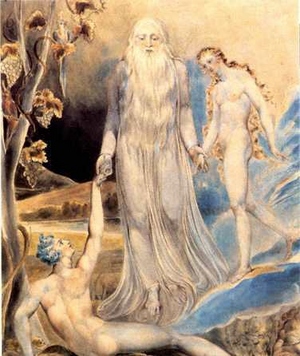I thought it was about time to give some thought to the females of myth and legend, beginning with one of the most controversial figures; that of Lilith. Her name shows up in several cultures, albeit in many different forms. Let’s explore some of them.
According to Jewish folklore, Lilith was the first wife of Adam. However, there seems to be some disagreement about “how” she was made. Some subscribe to the theory that she was made from dust just like Adam. Others believe that she and Adam were twins formed together and then split apart. Either way, Lilith felt herself equal to Adam in every way and refused to be submissive to him.
Her unwillingness to bend to Adam’s will became a bone of contention not only between him and her, but also with that of God. The legends all agree on one thing. Lilith apparently continued to refuse to accept a second place position to Adam. God, in frustration and anger, eventually banished her from the Garden of Eden and later presented Adam with a more docile female named Eve.
What happened to Lilith after that is a matter of great speculation. Some say she lived near the Red Sea. Others claim she hid in caves, out of the direct sight of God. The truth is, no one really knows for sure; assuming, of course, that she ever existed at all.
The legend of Lilith is a woven into a lot of ancient folklore, including that of countries like Iran, Babylon, Germany, Greece, Japan, Mexico and even Native America. However, the legends vary greatly. Let’s explore some of the most well known.
Some Muslims believe that Lilith, in her contempt for both Adam and God, slept with Satan himself. The union resulted in a race of demonic children that were called the Djinn (more commonly referred to as Genies). A similar variation was popular in much of Europe during Medieval times.
Other cultures varied the idea somewhat by saying that she only slept with demons, not Satan himself. But all agree on one point; that Lilith begot many demon children who went out to create havoc throughout the world.
Some cultures believed that Lilith herself became a demon; one with a penchant for attacking men as they slept in order to propagate even more demonic children. Again, whatever the version, it seemed that Lilith was inexplicably linked to demons and demonic children.
Some claim that Lilith and the Babylonian Goddess Belit-ili were one and the same. The Canaanites called her Baalat, which oddly enough translated to “divine lady.” To the Etruscans, she was called Lenith, a being without a face who waited at the gates of the underworld to receive the souls of the dead.
Some believed that Lilith was quite beautiful, but extremely vain. They say that she could look at her own reflection in the mirror for hours. Accordingly, her demon children, wherever they might be in the world, could reach their mother through any mirror; the one place they knew she would always be.
Still others believe that Lilith was merely created out of man’s need to subjugate women and make certain that religion remained a patriarchy. Few religious figures, with the major exception of Mary, were female. In fact, for the most part, females were always painted and written in a negative light. Lilith was often called “the ruination of the world.” There are certainly a lot of men who might say the same of some of the women in their lives.
There are those who also believe that Lilith was assigned as the ruler of the underworld. However, we’re not talking the kind of underworld associated with hell. This underworld is merely a lower level of creation; the one where mystical beings like fairies, leprechauns, and gnomes dwell.
Supposedly, this level of existence is so close to our own that, at times, a bleed through happens which allows humans to have a brief encounter with the beings of that world. That certainly would account for the hundreds of recorded accounts of people seeing fairies and leprechauns; assuming, of course, there is any truth to that theory.
There is only one recorded reference to Lilith in the Bible, in Isaiah 34:14. All references to her have disappeared from the canonical Bible. However, references to a group of women called lilim, remained in tact for more than a thousands of years. These supposed she-demons were often referred to as succubi; creatures that sought to copulate with men against their will.
Legend also equates Lilith to the sudden death of children, particularly boys. Many thought that Lilith strangled young infants in their sleep as part of her revenge against God. For hundreds of years it was common for pregnant women to wear a religious talisman or amulet that was meant to keep Lilith away.
Sometimes a ring was drawn around a newborn’s bed and inscribed with religious symbols or wording meant to ward off the she-demon. Special prayers were often said over newborns, invoking God’s protection from Lilith.
Male children were believed to be more vulnerable because of Lilith’s hatred of men. She supposedly preferred to take male babies during their first week of life. But females weren’t spared Lilith’s wrath. She just allowed them a little more time, sometimes not taking them until they had lived as many as three or four weeks.
For hundreds of years, Lilith was saddled as the cause for sudden infant death syndrome (SIDS); that is, of course, until humankind moved into an era of enlightenment. Most modern cultures have done away with any belief in Lilith at all. Only a handful of religions still hold onto the ancient beliefs.
As a Christian, I don’t believe in the legend of Lilith myself. However, I’m smart enough to know that I don’t possess the knowledge of the world. Therefore, I cannot dismiss any possibility. Myths and legends are often rooted in some form of truth. What that might be with regard to the legend of Lilith, I have no idea, but it certainly does make for interesting speculation.



